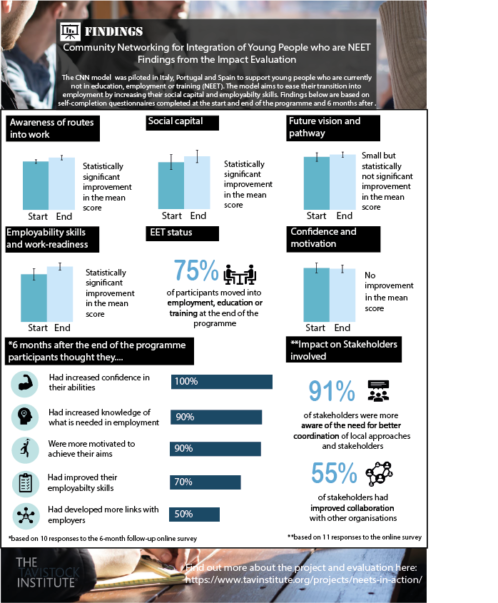Sharing more findings from the impact evaluation of the European project aimed at NEETs.
In our
last blog, we focused on findings related to the social capital gains of young people who participated in the programme as part of the European Project “
Community Networking for Young People who are NEET”. The programme also had many other positive outcomes for participants. For example the programme:
- increased their awareness of routes into work;
- gave them a clearer vision and pathway for their future;
- increased their employability skills, motivation, and self-confidence.
Overall, the project sought to provide an alternative solution to strategies and policies previously implemented by utilising and strengthening community networks. Therefore, the project further aimed to increase stakeholders’ awareness of the need for better coordination of local approaches and stakeholders as well as increase their collaboration with other organisations.
The developed model for the integration of NEETs (the so-called CNN model) based on European good practice examples was tested in Italy, Spain, and Portugal. After a preparation phase which included the selection of young people who are NEET as well as the initial formation of the local community and stakeholder network, the main part of the piloting involved supporting NEETs and building the network. Across Spain, Italy, and Portugal, more than 60 young people who were NEET engaged in the project and took part in individual coaching-based sessions, group sessions and job-experiences such as company visits. At the same time, community networks were developed and maintained to create a shared ambition and understanding of ways to integrate NEETs as well as to give them a better opportunity to gain access to the world of work.
The theory-based impact evaluation ran alongside the piloting to assess the impact of the model, drawing on survey and interview data. When comparing responses to the self-completion questionnaires at the start and the end of the programme, young people showed statistically significant improvements in their employability skills, their awareness of employment or training options as well as their social capital (see figure below). In addition, at the end of the programme, 40 of the 53 participants who completed the programme across the three countries were in employment, education, or training. We were not able to measure any statistically significant improvement in young people’s confidence over the course of the programme, even though all young people who completed an online survey 6-months after the end reported that they felt more confident in their abilities. At a community level, stakeholders reported an increase in awareness of the need for better coordination of local approaches for the integration of NEETs (see figure below). More than half of the stakeholders had expanded their network as well as increased collaboration with others.
From reviewing all the findings, the evaluation evidenced a successful application of the model in three different contexts with promising outcomes. Not all activities of the model have been implemented, due to several constraints, and there were differences in the implementation of the model per country. Overall, the CNN model makes a strong case for using such a community network approach to provide an improved pathway for re-integrating young people who are NEET.
 Find out more on the Neets in Action website and on our project page.
Find out more on the Neets in Action website and on our project page.

 Find out more on the Neets in Action website and on our project page.
Find out more on the Neets in Action website and on our project page.